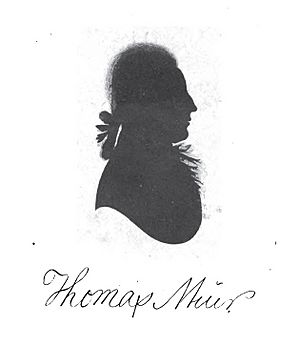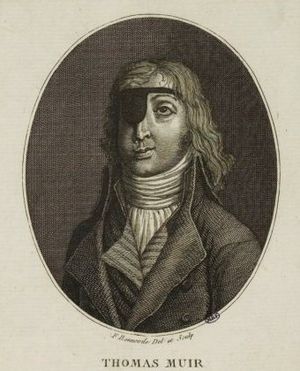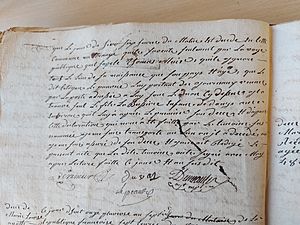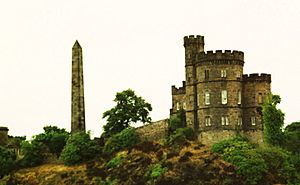Thomas Muir of Huntershill facts for kids
Quick facts for kids
Thomas Muir
|
|
|---|---|
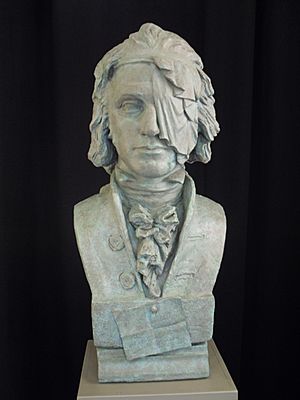
Thomas Muir depicted after being injured (bust by Alexander Stoddart)
|
|
| Born | 24 August 1765 |
| Died | 25 January 1799 (aged 33) Chantilly, French Republic
|
| Nationality | Scottish |
| Occupation | Lawyer |
| Known for | Friends of the People; Political Martyrs' Monument |
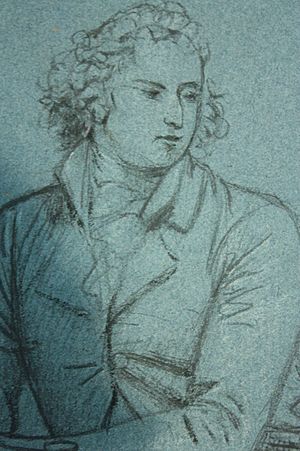
Thomas Muir (born August 24, 1765 – died January 25, 1799) was a Scottish lawyer and political reformer. He was also known as Thomas Muir the Younger of Huntershill. Muir studied at Edinburgh University and became a lawyer in 1787 when he was 22 years old. He was a main leader of a group called the Society of the Friends of the People.
Muir was one of five important reformers honored on the Political Martyrs' Monument in Edinburgh. The others were Thomas Fyshe Palmer, William Skirving, Maurice Margarot, and Joseph Gerrald. In 1793, they were all sent to Botany Bay in Australia because they were accused of speaking out against the government.
In 1796, Muir made a daring escape from Australia on an American ship called the Otter. He sailed across the huge Pacific Ocean to Nootka Sound on Vancouver Island. The ship's first mate, Pierre François Péron, wrote about Muir's escape and his journey across the Pacific to Monterey, California.
From California, Muir traveled to Mexico City. He was later held in Havana, Cuba, and then taken by a Spanish ship to Cádiz, Spain. His ship got into a fight with British warships, and Muir was badly hurt in the face. In September 1797, the Spanish government let him go. Weak from his injuries, Muir traveled to France with help from a French officer. He arrived in Bordeaux in November 1797 and was seen as a hero. He then went to Paris. Muir died in Chantilly, France, on January 25, 1799. Before he died, he said they had helped bring back the spirit of their country.
Forty years after the Society of the Friends of the People was founded, the Reform Act of 1832 brought in many changes they had asked for. This law removed unfair representation from some areas and gave more power to places with larger populations. It also allowed more men to vote.
Contents
- What Was Thomas Muir's Early Life Like?
- How Did Thomas Muir Get His Education?
- Why Was Thomas Muir Expelled from University?
- How Did Thomas Muir Become a Voice for the People?
- What Was Thomas Muir's Role in the French Revolution?
- Why Was Thomas Muir Charged with Sedition?
- What Happened at the Third Reform Convention?
- Thomas Muir's Journey to Australia
- Life in the Penal Colony
- How Did Thomas Muir Escape to America?
- Thomas Muir's Return to Europe
- Thomas Muir's Final Days in France
- The Political Martyrs Remembered
- Thomas Muir's Relatives
- How Thomas Muir Is Honored Today
- See Also
What Was Thomas Muir's Early Life Like?
Thomas Muir was born in Glasgow, Scotland. His family lived above his father's grocery shop on the High Street. His father, James Muir, was a successful hop merchant. He bought a property called Huntershill House in the 1780s.
Both of Muir's parents were strict Presbyterians. This meant young Thomas grew up with strong moral values. People described him as a "pious child" who was modest and quiet.
How Did Thomas Muir Get His Education?
Muir started his education at age five with a private tutor. When he was only 10, in 1775, he began studying at Glasgow University. He later focused on studying divinity, which is the study of religion.
In 1782, at 17, Muir earned his Master of Arts degree. He then decided not to become a church minister. Instead, he became interested in law and government, influenced by his teacher John Millar. Muir joined student clubs where they debated important topics like American Independence.
Why Was Thomas Muir Expelled from University?
In 1784, a disagreement happened at Glasgow University between a professor and other staff. Muir and other students supported the professor. They wrote a pamphlet about the issue.
The university started disciplinary actions against them. Muir and his friends asked for a lawyer, but this was not allowed. So, Muir decided to leave the university on his own.
He then went to Edinburgh University to finish his law studies. He passed his exams and became a lawyer in 1787.
How Did Thomas Muir Become a Voice for the People?
Muir was an Elder in the Church of Scotland. In 1790, he got involved in a dispute with local landlords. He stood up for the church members against the landlords. Muir fought their case all the way to the General Assembly, and he won.
Muir became known as a man who stood by his beliefs. He openly said that many laws were unfair to poor people. Younger lawyers respected him and called him "the Chancellor." However, judges like Lord Braxfield did not like his ideas about changing laws.
What Was Thomas Muir's Role in the French Revolution?
The French Revolution in 1789 gave hope to people in Scotland and England who wanted to reform their government. In 1792, a group called the London Association of the Friends of the People was formed.
In Scotland, many clubs also supported the French Revolution. Thomas Muir and William Skirving helped create a Scottish version of the Friends of the People. Unlike the London group, the Scottish group welcomed people from all social classes. This new movement grew quickly.
Muir traveled to London to meet with the Friends of the People leaders. They were worried that the execution of Louis XVI in France would harm reform efforts in Britain. Muir agreed to go to France to try and convince the French leaders to save the King's life. He spoke with some leaders, but their power was fading.
Why Was Thomas Muir Charged with Sedition?
Muir returned to Scotland in August 1792. He helped start the Glasgow Society of Friends of the People. He also traveled around, helping new societies form. In November, Muir called for a big meeting of reform societies in Edinburgh.
At this meeting, an "Address of Fraternity" arrived from a group called the United Irishmen. Muir liked this message, but some delegates thought it was too extreme. Muir read the address aloud and said that Scotland should not be "melted down into another country."
The government's chief lawyer, Robert Dundas, started investigating Muir. On January 2, 1793, Muir was arrested for sedition, which means speaking or acting against the government. He was released on bail.
Muir then went to London and later to France. He hoped to persuade French leaders to spare the King's life. While in Paris, he met Thomas Paine.
When war broke out with France, the government in Scotland became stricter. Dundas moved Muir's trial date forward. Muir was declared a fugitive for not appearing in court. In March 1793, Muir was removed from the list of lawyers.
Muir returned to Scotland in August 1793. He was immediately arrested in Portpatrick. He was taken to Tolbooth prison in Edinburgh. On August 30 and 31, he faced charges of making "seditious speeches" and sharing "seditious publications" like Rights of Man. The judge focused on Muir's connection to the United Irishmen.
Muir was sentenced to 14 years of transportation to Australia. He was sent to a prison ship and later to the Hulks at Woolwich. He was joined by Thomas Fyshe Palmer, who also received a transportation sentence.
What Happened at the Third Reform Convention?
A third meeting of the Friends of the People, called the 'British Convention,' took place. This meeting was mostly led by three English delegates: Maurice Margarot, Joseph Gerrald, and Matthew Campbell Browne.
These men realized that the Scottish reform movement was much more united than the English one. They became very bold, using terms like "Citizen President" and renaming the meeting the 'British Convention,' copying the French. Muir later called this a "miserable plaything of the English Government."
A delegate suggested that a special committee should be able to call an emergency meeting. This meeting would declare itself permanent and resist being broken up. When the authorities learned of this, they quickly arrested Skirving, Margarot, Gerrald, and others. They were all sentenced to 14 years of transportation.
Muir and Palmer were held in prison ships and forced to work in chain gangs. After a failed attempt to send them on one ship, they were put on a new transport ship called Surprize. Despite efforts by some politicians to get them pardoned, they were sent to Botany Bay on May 24, 1794.
Thomas Muir's Journey to Australia
On May 1, 1794, the Surprise sailed from England to Sydney. Muir, Palmer, Skirving, and Margarot were on board. The French navy tried to rescue them, but the Surprise sailed with a strong group of other ships. The ship arrived in Sydney on October 25, 1794.
During the long trip, there was an attempt to accuse Muir and his friends of planning a mutiny. This attempt failed, and the reformers were able to prove their innocence when they arrived in Australia.
Life in the Penal Colony
Muir's time in the penal colony was mostly quiet. As political prisoners, Muir and his friends had more freedom than regular convicts. They had received money from supporters in London. This allowed them to buy their own supplies and avoid forced labor.
In November, they were given brick huts. They bought plots of land. Muir bought a small hut and land on the other side of the bay. This allowed him to be less observed by the Governor. It also gave him a reason to keep a small boat.
How Did Thomas Muir Escape to America?
In early 1796, with help from a French sailor named Pierre François Péron, Muir planned his escape. He arranged to leave on an American ship called the Otter. The ship's captain said Muir and anyone else had to escape the harbor on their own.
Muir contacted his fellow prisoners. However, only he was able to go. Skirving was too weak from illness. Gerrald was very sick, and Palmer refused to leave him. Margarot was away and had been avoided by the others.
On the evening of February 17, 1796, Muir and two servants quietly rowed out of the harbor in his small boat. They avoided being seen and reached the Otter. Muir left a note giving his books to Palmer and thanking the Governor. He said he planned to practice law in America.
The Otter sailed across the Pacific Ocean and reached Nootka Sound on June 22, 1796. Muir learned that a British warship was nearby. Being caught meant immediate execution. Luckily, Muir spoke Spanish. He convinced a Spanish ship captain to take him to Monterey, California.
In Monterey, Muir met the Governor, Don Diego Borica, who was impressed by him. However, the Viceroy in Mexico City became suspicious of Muir. He ordered Muir to be sent to Spain as a suspected spy. Muir was taken to Vera Cruz and then to Havana, Cuba.
Thomas Muir's Return to Europe
In Havana, Muir tried to escape but was caught and imprisoned. He managed to contact a French agent, who wrote to the French government about Muir's situation. By the time the letter arrived, Muir had already sailed for Spain.
On April 26, 1797, Muir's ship, the Ninfa, was attacked by British warships near Cadiz Harbour. Muir asked to be put ashore because he did not want to fight against his own countrymen. During the battle, Muir was badly injured in the face by shrapnel. His left cheekbone was smashed, and his eyes were hurt. He was so disfigured that his captors did not recognize him, and he was sent ashore with the wounded.
Thomas Muir's Final Days in France
On September 16, 1797, the Spanish government finally released Muir. He was still weak from his injuries. He traveled to France through Madrid and San Sebastian, helped by a French officer.
In November 1797, he arrived in Bordeaux, France. He was celebrated as a "Hero of the French Republic." His last portrait shows him with a large black patch over his left eye. His face was disfigured, showing his teeth in a permanent grimace. Muir, weak and partly blind, slowly made his way to Paris, arriving on February 4, 1798.
In Paris, Muir was welcomed as a hero. He made it clear that his main concern was helping his suffering countrymen. He met with Thomas Paine and James Napper Tandy. He learned about the growing unrest in Scotland. During 1798, he wrote many letters to the French government, urging them to help the Scottish people create a Scottish Republic.
Muir's main contact in 1798 was Dr. Robert Watson. From Watson, Muir learned about the strength of the United Scotsmen, a new revolutionary group. Muir moved secretly to the village of Chantilly in November 1798 to meet with Scottish delegates.
He died there on January 25, 1799. The record of his death states he was found dead by a 12-year-old boy.
When news of his death reached Paris, an obituary said he died from his old wounds.
The Political Martyrs Remembered
Thomas Muir was the most important of the five "Political Martyrs" honored at the Political Martyrs' Monument. The others were Thomas Fyshe Palmer, William Skirving, Maurice Margarot, and Joseph Gerrald. These men were sent to Australia for speaking out about parliamentary reform.
Thomas Muir's Relatives
William Muir, known as the Campsie Poet, was a relative of Thomas Muir. Thomas Muir was also a cousin of William Muir (1767–1843), a shipowner. Thomas wrote to William, asking him to remember him to his parents.
Thomas Muir was buried outside the church graveyard in Chantilly because he was not Catholic. This graveyard is now covered by a parking lot.
How Thomas Muir Is Honored Today
After the Reform Act of 1832, people began a campaign to honor Thomas Muir and his fellow reformers. Two large monuments were built with money raised by public donations. One is in Edinburgh, and the other is in Nunhead Cemetery in London.
The monument in Old Calton Cemetery in Edinburgh was designed in 1844. It is 90 feet (27 meters) tall.
The monument has a message:
To The Memory of Thomas Muir, Thomas Fyshe Palmer, William Skirving, Maurice Margarot and Joseph Gerrald. Erected by the Friends of Parliamentary Reform in England and Scotland, 1844.
It also includes two quotes. One from Muir says:
I have devoted myself to the cause of The People. It is a good cause – it shall ultimately prevail – it shall finally triumph.
The other from Skirving says:
I know that what has been done these two days will be Re-Judged.
The Nunhead monument was built in 1837 and is 40 feet (12 meters) tall.
A stone monument (Cairn) and a gate called Martyrs Gate were built at Huntershill Village.
A local artist painted a series of watercolours showing Thomas Muir's escape from Botany Bay. These paintings are displayed in the Thomas Muir Coffee Shop.
There is a permanent exhibition about Thomas Muir at Bishopbriggs library. It includes a bust of him by artist Alexander Stoddart. Thomas Muir Street in Greenock is named after him. A school in Bishopbriggs, the Thomas Muir High School, was named after him in 1981. It later merged with another school in 2003.
In 2022, a mural of Thomas Muir was painted in Glasgow.
The famous poet Robert Burns wrote his song Scots Wha Hae on the day Muir's trial began. Burns's letters suggest that the song was inspired by Muir's fight for freedom.
See Also
- List of convicts transported to Australia
- Jeffrey Street or Jeffreys Street, Kirribilli


